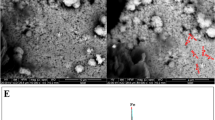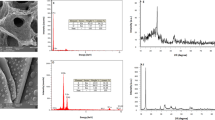Abstract
Several problems for the direct electrochemical oxidation of reduced glutathione (GSH) challenge the usage of electroanalytical techniques for its determination. In this work, the electrochemical oxidation of GSH catalyzed by gold nanoparticles electrodeposited on Nafion modified carbon paste electrode in 0.04 mol L−1 universal buffer solution (pH 7.4) is proved successful. The effect of various experimental parameters including pH, scan rate and stability on the voltammetric response of GSH was investigated. At the optimum conditions, the concentration of GSH was determined using differential pulse voltammetry (DPV) in two concentration ranges: 0.1 × 10−7 to 1.6 × 10−5 mol L−1 and 2.0 × 10−5 to 2.0 × 10−4 mol L−1 with correlation coefficients 0.9988, 0.9949 and the limit of detections (LOD) are 3.9 × 10−9 mol L−1 and 8.2 × 10−8 mol L−1, respectively, which confirmed the sensitivity of the electrode. The high sensitivity, wide linear range, good stability and reproducibility, and the minimal surface fouling make this modified electrode useful for the determination of spiked GSH in urine samples and in tablet with excellent recovery results obtained.









Similar content being viewed by others
References
Black M (1984) Acetaminophen hepatotoxicity. Ann Rev Med 35:577–593
Lock J, Davis J (2002) The determination of disulphide species within physiological fluids. Trends Anal Chem 21(12):807
Halliwell B, Gutteridge JMC (2007) Free Radicals in Biology and Medicine, 4th edn. Oxford University Press, Oxford, pp 114–115
Rawn JD (1983) in: Harper and Row (eds) Biochemistry, New York, p. 657
Chen J, He Z, Liu H, Cha C (2006) Electrochemical determination of reduced glutathione (GSH) by applying the powder microelectrode technique. J Electroanal Chem 588(2):324–330
Penninckx M (2000) A short review on the role of glutathione in the response of yeasts to nutritional, environmental, and oxidative stresses. Enzyme Microb Technol 26(9–10):737–742
Srinivas B, Michael H, Deepinder K, Subramanian R, Julie KA (2002) Glutathione, iron and Parkinson’s disease. Biochem Pharmacol 64(5–6):1037–1048
Kirlin WG, Cai J, Thompson SA, Diaz D, Kavanagh TJ, Jones DP (1999) Glutathione redox potential in response to differentiation and enzyme inducers. Free Rad Biol Med 27(11–12):1208–1218
Lomaestro BM, Malone M (1995) Glutathione in health and disease: pharmacotherapeutic issues. Ann Pharmacother 29:1263–1273
Sudeep PK, Joseph STS, Thomas KG (2005) Selective Detection of Cysteine and Glutathione Using Gold Nanorods. J Am Chem Soc 127(18):6516–6517
Cereser C, Guichard J, Drai J, Bannier E, Garcia I, Boget S, Parvaz P, Revol A (2001) Quantitation of reduced and total glutathione at the femtomole level by high-performance liquid chromatography with fluorescence detection: application to red blood cells and cultured fibroblasts. J Chromatogr B: Biomed Sci Appl 752(1):123–132
Zhang W, Wan F, Zhu W, Xu H, Ye X, Cheng R, Jin LT (2005) Determination of glutathione and glutathione disulfide in hepatocytes by liquid chromatography with an electrode modified with functionalized carbon nanotubes. J Chromatogr B 818(2):227–232
Shen Z, Wang H, Liang SC, Zhang ZM, Zhang HS (2002) Spectrofluorimetric determination of reduced glutathione in human blood using N-[p-(2-benzothiazolyl)phenyl]maleimide. Anal Lett 35(14):2269–2278
Chen XP, Cross RF, Clark AG, Baker WL (1999) Analysis of reduced glutathione using a reaction with 2,4'-dichloro-1-(naphthyl-4-ethoxy)-s-triazine (EDTN). Mikrochim Acta 130(4):225–231
Besada A, Tadros NB, Gawargious YA (1989) Copper(II)-neocuproine as color reagent for some biologically active thiols: spectrophotometric determination of cysteine, penicillamine, glutathione, and 6-mercaptopurine. Mikrochim Acta 3(1–2):143–146
Raggi MA, Nobile L, Giovannini AG (1991) Spectrophotometric determination of glutathione and of its oxidation product in pharmaceutical dosage forms. J Pharm Biomed Anal 9(10–12):1037–1040
Pacsial-Ong EJ, McCarley RL, Wang WH, Strongin RM (2006) Electrochemical detection of glutathione using redox indicators. Anal Chem 78(21):7577–7581
Vandeberg PJ, Johnson DC (1993) Pulsed electrochemical detection of cysteine, cystine, methionine, and glutathione at gold electrodes following their separation by liquid chromatography. Anal Biochem 65(20):2713–2718
Jin WR, Dong Q, Ye XY, Yu DQ (2000) Assay of Glutathione in Individual Mouse Peritoneal Macrophages by Capillary Zone Electrophoresis with Electrochemical Detection. Anal Biochem 285(2):255–259
Jin WR, Li XJ, Gao N (2003) Simultaneous determination of tryptophan and glutathione in individual rat hepatocytes by capillary zone electrophoresis with electrochemical detection at a carbon fiber bundle-Au/Hg dual electrode. Anal Chem 75(15):3859–3864
Ling BL, Baeyens WRG, Dewaele C, Del Castillo B (1992) Packed capillary liquid chromatography coupled to fluorescence detection: Application to human blood samples for the determination of glutathione. J Pharmaceut Biomed 10(10–12):985–988
Janeš L, Lisjak K, Vanzo A (2010) Determination of glutathione content in grape juice and wine by high-performance liquid chromatography with fluorescence detection. Anal Chim Acta 674(2):239–242
Cai HH, Wang H, Wang J, Wei W, Yang PH, Cai J (2012) Naked eye detection of glutathione in living cells using rhodamine B-functionalized gold nanoparticles coupled with FRET. Dye Pigment 92(1):778–782
Głowacki R, Bald E (2009) Fully automated method for simultaneous determination of total cysteine, cysteinylglycine, glutathione and homocysteine in plasma by HPLC with UV absorbance detection. J Chromatogr B 877(28):3400–3404
Burns SA, Hong YJ, Mitchell AE (2004) Direct liquid chromatography–mass spectrometry method for the detection of glutathione S-transferase isozymes and investigation of their expression in response to dietary flavone. J Chromatogr B 809(2):331–337
Atta NF, Galal A, Abu-Attia FM, Azab SM (2011) Simultaneous determination of paracetamol and neurotransmitters in biological fluids using a carbon paste sensor modified with gold nanoparticles. J Mater Chem 21:13015–13024
Atta NF, El-Kady MF (2010) Novel poly(3-methylthiophene)/Pd, Pt nanoparticle sensor: Synthesis, characterization and its application to the simultaneous analysis of dopamine and ascorbic acid in biological fluids. Sens Actuators B: Chem 145(1):299–310
Atta NF, El-Kady MF, Galal A (2009) Palladium nanoclusters-coated polyfuran as a novel sensor for catecholamine neurotransmitters and paracetamol. Sens Actuators B-Chem 14(2):566–574
Atta NF, Abdel-Mageed AM (2009) Smart electrochemical sensor for some neurotransmitters using imprinted sol–gel films. Talanta 80(2):511–518
Atta NF, Galal A, Ahmed RA (2011) Poly(3,4-ethylene-dioxythiophene) electrode for the selective determination of dopamine in presence of sodium dodecyl sulfate. Bioelectrochemistry 80(2):132–141
Calvo-Marzal P, Chumbimuni-Torres KY, Höehr NF, Kubota LT (2006) Determination of glutathione in hemolysed erythrocyte with amperometric sensor based on TTF-TCNQ. Clin Chim Acta 371(1–2):152–158
Salimi A, Hallaj R (2005) Catalytic oxidation of thiols at preheated glassy carbon electrode modified with abrasive immobilization of multiwall carbon nanotubes: applications to amperometric detection of thiocytosine, l-cysteine and glutathione. Talanta 66(4):967–975
Compagnone D, Federici G, Scarciglia L (1933) Amperometric glutathione electrodes. Biosens Biolelectron 8(5):257–263
Compagnone D, Federici G, Scarciglia L, Palleschi G (1994) Flow-through analysis of glutathione in human erythrocytes with an amperometric biosensor. Anal Lett 27(1):15–27
Zhang S, Sun WL, Zhang W, Qi WY, Jin LT, Yamamoto K, Tao S, Jin JY (1999) Determination of thiocompounds by liquid chromatography with amperometric detection at a Nafion/indium hexacyanoferrate film modified electrode. Anal Chim Acta 386(1–2):21–30
Salimi A, Pourbeyram S (2003) Renewable sol–gel carbon ceramic electrodes modified with a Ru-complex for the amperometric detection of L-Cysteine and glutathione. Talanta 60(1):205–214
Filanovsky B (1999) Electrochemical response of new carbon electrodes bulk modified with cobalt phthalocyanine to some thiols in the presence of heptane or human urine. Anal Chim Acta 394(1):91–100
Banica FG, Fogg AG, Moreira JC (1995) Catalytic cathodic stripping voltammetry of oxidized glutathione at a hanging mercury drop electrode in the presence of nickel ion. Talanta 42(2):227–234
Oshea TJ, Lunte SM (1993) Selective detection of free thiols by capillary electrophoresis-electrochemistry using a gold/mercury amalgam microelectrode. Anal Chem 65:247–250
Owens GS, LaCourse WR (1996) Pulsed electrochemical detection of sulfur-containing compounds following microbore liquid chromatography. Current Sep 14:82–88
Miao P, Liu L, Nie Y, Li G (2009) An electrochemical sensing strategy for ultrasensitive detection of glutathione by using two gold electrodes and two complementary oligonucleotides. Biosens Bioelectron 24(11):3347–3351
Raoof JB, Ojani R, Baghayeri M (2009) Simultaneous electrochemical determination of glutathione and tryptophan on a nano-TiO2/ferrocene carboxylic acid modified carbon paste electrode. Sensor Actuat B-Chem 143(1):261–269
Lima PR, Santos WJR, Oliveira AB, Goulart MOF, Kubota LT (2008) Electrocatalytic activity of 4-nitrophthalonitrile-modified electrode for the l-glutathione detection. J Pharmaceut Biomed 47(4–5):758–764
Atta NF, Galal A, Abu-Attia FM, Azab SM (2011) Characterization and electrochemical investigations of micellar/drug interactions. Electrochim Acta 56(5):2510–2517
Atta NF, Galal A, Abu-Attia FM, Azab SM (2010) Carbon paste-gold nanoparticles sensor for the selective determination of dopamine in buffered solutions. J Electrochem Soc 157(9):116–123
Shahrokhian S, Ghalkhani M (2006) Simultaneous voltammetric detection of ascorbic acid and uric acid at a carbon-paste modified electrode incorporating thionine–nafion ion-pair as an electron mediator. Electrochim Acta 51(13):2599–2606
Zuman P (1969) The Elucidation of Organic Electrode Processes. Academic Press, New York, p 21
Jiang X, Lin X (2005) Overoxidized polypyrrole film directed DNA immobilization for construction of electrochemical micro-biosensors and simultaneous determination of serotonin and dopamine. Anal Chim Acta 537(1–2):145–151
Zhou M, Ding J, Guo LP, Shang QK (2007) Electrochemical behavior of l-cysteine and its detection at ordered mesoporous carbon-modified glassy carbon electrode. Anal Chem 79(14):5328–5335
Atta NF, Darwish SA, Khalil SE, Galal A (2007) Effect of surfactants on the voltammetric response and determination of an antihypertensive drug. Talanta 72(4):1438–1445
Qijin W, Nianjun Y, Haili Z, Xinpin Z, Bin X (2001) Voltammetric behavior of vitamin B2 on the gold electrode modified with a self-assembled monolayer of l-cysteine and its application for the determination of vitamin B2 using linear sweep stripping voltammetry. Talanta 55(3):459–467
Vasantha VS, Chen SM (2006) Electrocatalysis and simultaneous detection of dopamine and ascorbic acid using poly(3,4-ethylenedioxy) thiophene film modified electrodes. J Electroanal Chem 592(1):77–87
Li J, Lin XQ (2007) Electrodeposition of gold nanoclusters on overoxidized polypyrrole film modified glassy carbon electrode and its application for the simultaneous determination of epinephrine and uric acid under coexistence of ascorbic acid. Anal Chim Acta 596(2):222–230
Nasri Z, Shams E (2009) Application of silica gel as an effective modifier for the voltammetric determination of dopamine in the presence of ascorbic acid and uric acid. Electrochim Acta 54(28):7416–7421
Dawson RMC (1959) Data for Biochemical Research. Clarendon Press, Oxford
Abiman P, Wildgoose GG, Compton RG (2007) Electroanalytical exploitation of nitroso phenyl modified carbon-thiol interactions: Application to the low voltage determination of thiols. Electroanalysis 19(4):437–444
Xu F, Wang L, Gao M, Jin J, Jin J (2002) Amperometric determination of glutathione and cysteine on a Pd-IrO2 modified electrode with high performance liquid chromatography in rat brain microdialysate. Anal Bioanal Chem 372(7–8):791–794
Nekrassova O, Lawrence NS, Compton RG (2003) Electrochemically initiated catalytic oxidation of 5-thio-2-nitrobenzoic acid (TNBA) in the presence of thiols at a boron doped diamond electrode: Implications for total thiol detection. Electroanalysis 21(15):1655–1660
Chen G, Zhang LY (2004) Wang J (2004) Miniaturized capillary electrophoresis system with a carbon nanotube microelectrode for rapid separation and detection of thiols. Talanta 64(4):1018–1023
Gong KP, Zhang MN, Yan YM, Su L, Mao LQ, Xiong SX, Chen Y (2004) Sol − gel-derived ceramic − carbon nanotube nanocomposite electrodes: Tunable electrode dimension and potential electrochemical applications. Anal Chem 76:6500–6505
Wang HS, Zhang AM, Cui H, Liu DJ, Liu RM (2000) Adsorptive stripping voltammetric determination of erythromycin at a pretreated glassy carbon electrode. Microchem J 64(1):67–71
Acknowledgment
The authors would like to express their gratitude to the University of Cairo (Office of Vice President for Graduate Studies and Research) for providing partial financial support through “The Young Researchers’ Program.” We would like to acknowledge the financial support by the National Organization for Drug Control and Research (NODCAR, Egypt).
Author information
Authors and Affiliations
Corresponding author
Electronic supplementary material
Below is the link to the electronic supplementary material.
ESM 1
(PDF 674 kb)
Rights and permissions
About this article
Cite this article
Atta, N.F., Galal, A. & Azab, S.M. Novel sensor based on carbon paste/Nafion® modified with gold nanoparticles for the determination of glutathione. Anal Bioanal Chem 404, 1661–1672 (2012). https://doi.org/10.1007/s00216-012-6276-0
Received:
Revised:
Accepted:
Published:
Issue Date:
DOI: https://doi.org/10.1007/s00216-012-6276-0




